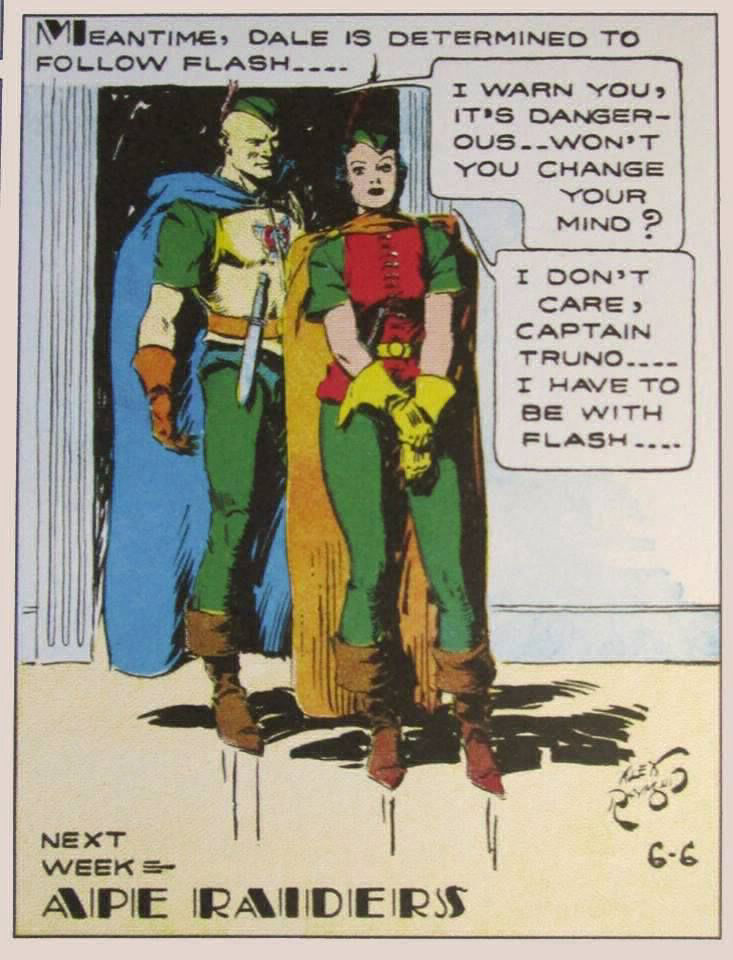
Batman’s creative team had decided to give the Batman a kid sidekick, but now they needed to come up with a name. Artist Bob Kane (until recently Batman's only "official" creator), writer Bill Finger (now finally "officially" acknowledged as co-creator) and others tossed around ideas. One suggestion was a super-powered kid named Mercury. But it was young assistant Jerry Robinson who came up with the winning idea, as he said in many interviews, such as the interview conducted by Jim Amash in Alter Ego #39 (Twomorrows, August 2004):
In reaching for a name, I came up with Robin. Everything in your life comes up in one form or another. I loved the stories of Robin Hood, and that’s where the name came from, despite other stories since. As a kid, I was given a book about Robin Hood and the Knights of the Round Table, illustrated by N.C. Wyeth. Wyeth was a great illustrator, and I used to pore over those drawings. I remembered those illustrations vividly, so when I got the idea for Robin’s name, I immediately thought of the Wyeth costume of Robin Hood. That’s where the red vest came from, the chain mail type of shorts, and the shoes.
- Jerry Robinson
Fans and scholars have also noticed another influence on Robin the Boy Wonder’s costume – a June 6, 1937 panel of the Flash Gordon comic strip. Flash’s girlfriend Dale Arden is wearing a costume that in both colour and detail resembles Robin’s costume. In the strip Dale is with Prnce Barin and his royal foresters – comic strip characters who were also inspired by Robin Hood and his Merry Men. Borrowing from Alex Raymond was nothing new. Comics historian Arlen Schumer has identified the very first Batman cover (Detective Comics #27) as a swipe of Raymond’s Flash Gordon. (Thanks to Michael Lane of Comics in the Golden Age for bringing this to my attention.)

And yet, with its fully-covered legs it more closely resembles Neal Adams 1990 redesign of the Robin costume than the 1940 Robinson/Kane original. Looking at some of Wyeth’s illustrations we do see aspects missing in the Flash Gordon art.
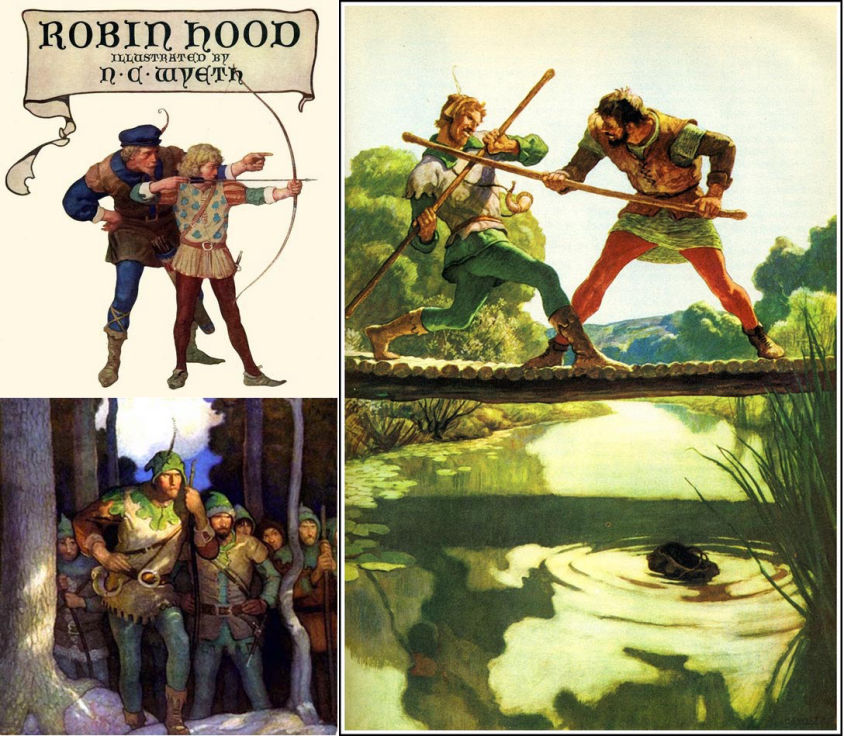
The Young Robin Hood in Wyeth’s title page has Robin the Boy Wonder’s pixie boots, and the quarterstaff duel between Robin Hood and Little John has the suggestion of chain mail shorts (more a skirt here) and the bare legs that Batman’s sidekick would adopt. And it’s also possible that Wyeth’s art was also an influence on Alex Raymond.
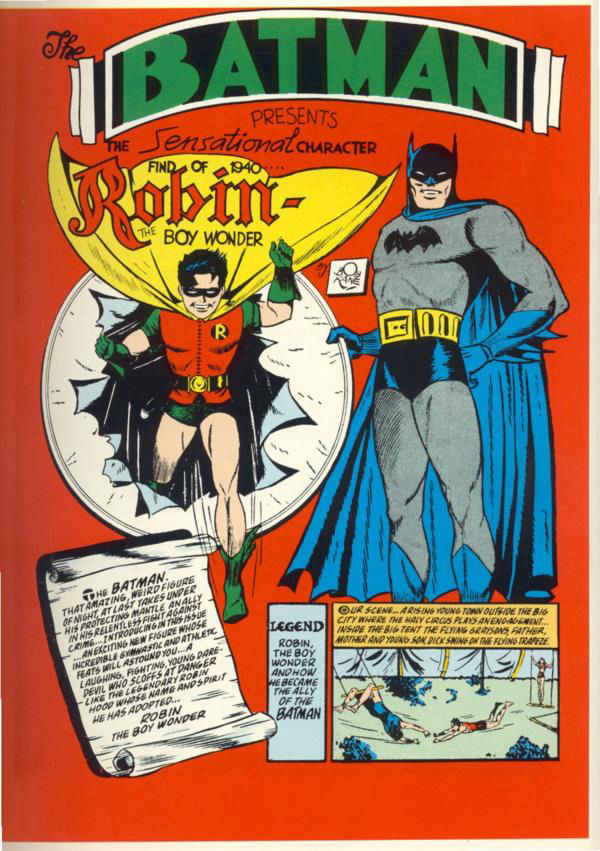
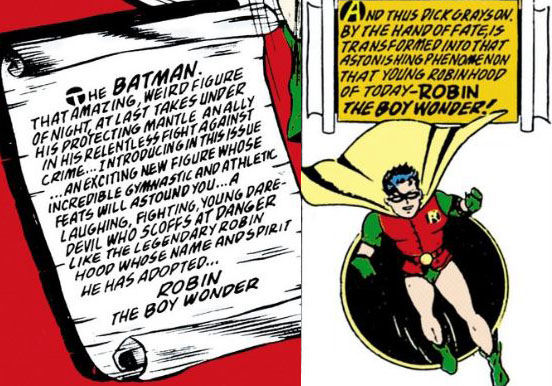
The Batman creative team made sure that readers knew where the sidekick's name had come from. The first page of the Boy Wonder's first appearance in Detective Comics #38 (April 1940) calls Robin a "young daredevil who scoffs at danger like the legendary Robin Hood whose name and spirit he has adopted" and later in the same story refers to him as "that young Robin Hood of today", a phrase repeated in the third story of Batman #1 (Spring 1940). And again in Detective Comics #40 (June 1940) Robin is referred to as the "young, laughing Robin Hood of today." Also, for the first couple of Robin's name in the title page for the stories is rendered in a gothic, blackletter font -- similar to what you'd find on the covers of many Robin Hood books. Later issues promote Robin's originality as "the original Boy Wonder", perhaps to distinguish him from the legion of copycat kid sidekicks who were quickly introduced into other superhero features.
Speaking of copycats, in 1941 DC Comics introduced Green Arrow and Speedy, two archer superheroes who dressed in Robin Hood like costumes, but resembled Batman and Robin in nearly all other respects. In both his first appearance (More Fun Comics #73, Nov. 1940) and first two origin stories, no attempt is made to compare Green Arrow to Robin Hood, despite the similarity of costume. Perhaps the writers felt the comparison was too obvious to be worth mentioning.
As time moved on, the Robin Hood connection with Batman's sidekick was downplayed in favour of reference to the bird, the American Robin. One bizarre example of this comes in Detective Comics #226 (cover dated December 1955), "When Batman was Robin". Batman explains that he himself was the first one to wear the Robin costume. As a teenager, Bruce Wayne concealed his identity when studying the art of detection under police detective Harvey Harris. When Harris saw Bruce's red, yellow and green costume, he says "since you're as brilliant as a robin redbreast in that costume, I'll call you -- Robin!"
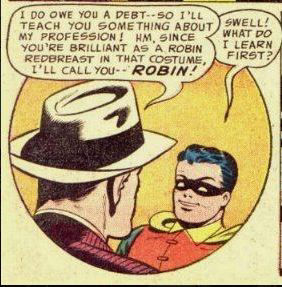
But the Robin Hood source of the name wasn't entirely forgotten. In Batman #213 (July 1969), writer E. Nelson Bridwell -- DC Comics' "continuity cop" -- and artists Ross Andru and Mike Esposito reconciled the various origins of Robin. Dick Grayson says "As you're Batman, maybe I could take the name of a different flying creature." Thinking of youthful adventures with Harvey Harris, Batman suggests the name Robin. Dick enthusiastically responds "Swell! Robin Hood was always one of my favourite heroes!" The same moment is replayed with more panache in The Untold Legend of Batman #2 from 1980 by writer Mike W. Barr and artist Jim Aparo
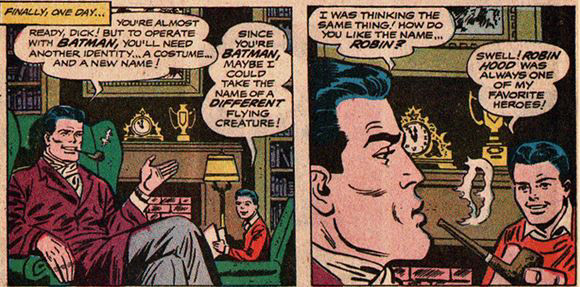

Robin Hood is also mentioned in another retelling of Robin's origins, this one in Batman #437 (August 1989) when the young hero is out on his first adventure he wants to make sure the crooks get his name right. "The name's Robin. That's one 'bee'. Like in Robin Hood, not robbin' hoods! That's what you creeps are."
The Emmy-winning 1993 episode of Batman: The Animated Series “Robin’s Reckoning, Part 1” adapted Robin’s origin from Detective Comics #38 and featured a wordless homage to the Boy Wonder’s inspiration. After his parents were murdered, young Dick Grayson was brought to Wayne Manor and given a large empty bedroom that once belonged to a young Bruce Wayne. On the wall over the door, we see a Robin Hood mural.
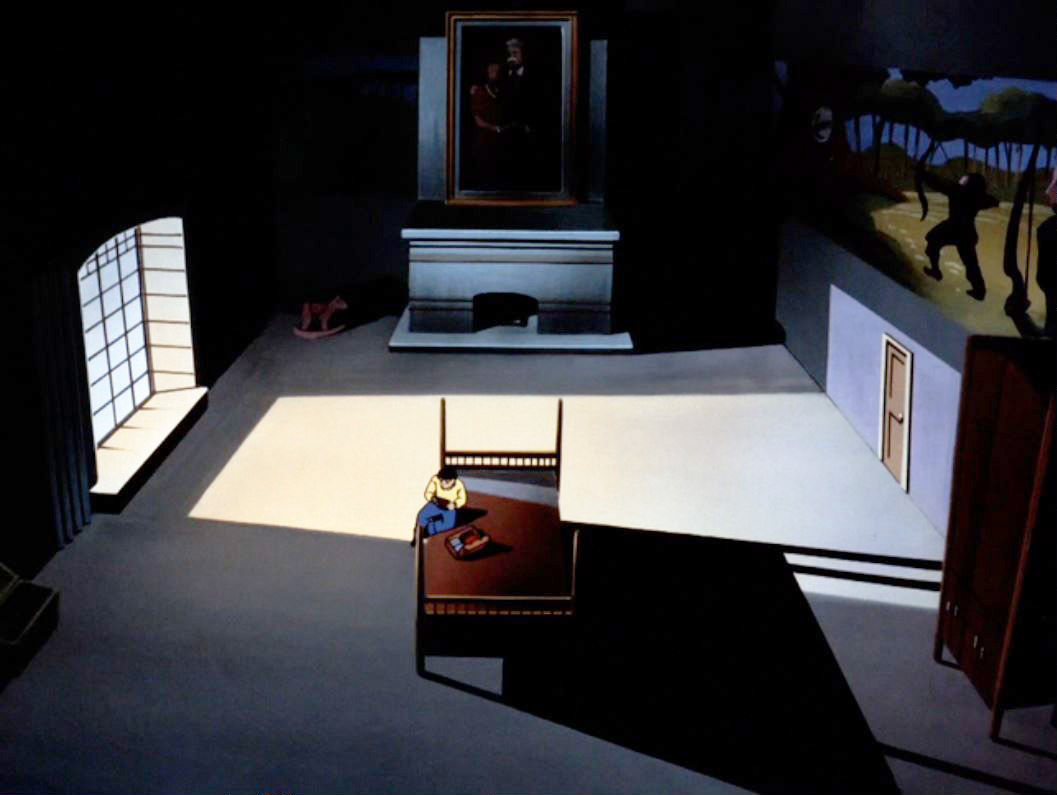
A similar visual connection had been made in “The Fear”, a 1985 episode of Galactic Guardians: The Super Powers Team, the retitled final season of the long-running Super Friends cartoon franchise. A flashback to Batman’s origin showed that the Waynes leaving a Robin Hood film prior to Bruce Wayne’s parents being killed in Crime Alley. When asked if he enjoyed the movie, the young Bruce replied "That Robin Hood was something else!"
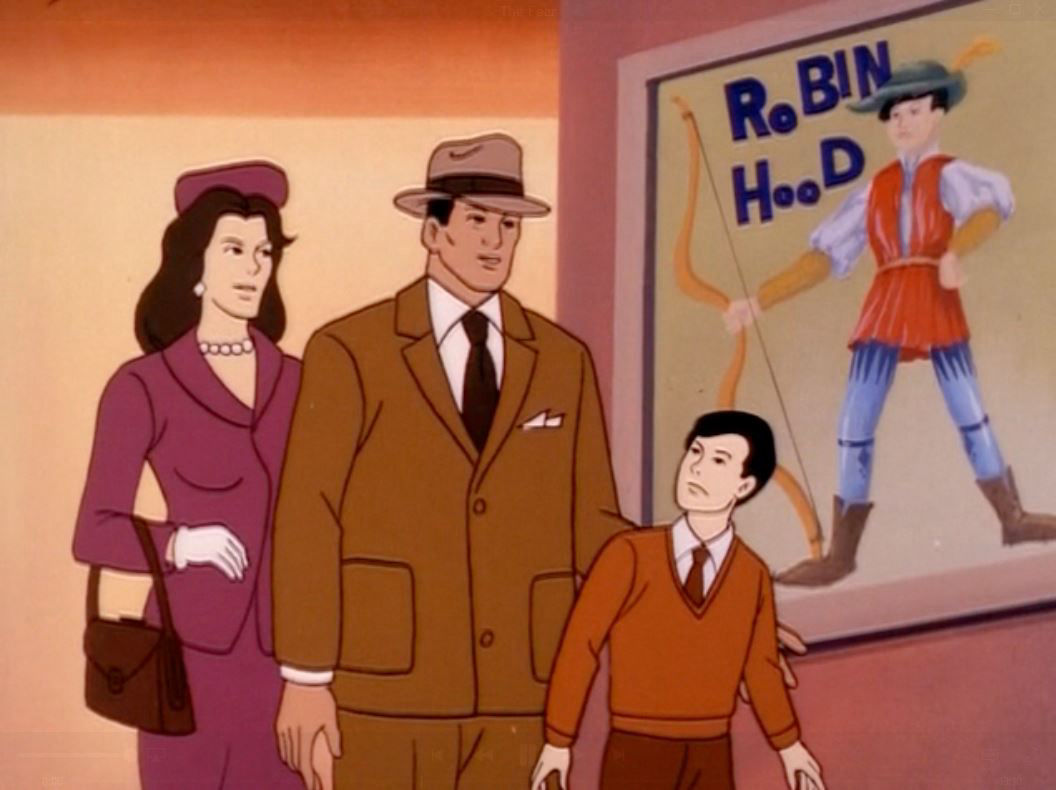
The comic book fans reading this article might be tempted to criticize the cartoon for this Robin Hood attribution. It's often been depicted that the film the young Bruce Wayne saw on the night his parents were murdered was 1940's The Mark of Zorro starring Tyrone Power. However, the Super Friends got there first. It wasn't until a year after the cartoon that writer / artist Frank Miller first made the Zorro connection in the comic books.
Although Miller himself also tied Errol Flynn's The Adventures of Robin Hood into Batman and Robin's history.
One of the most extensive modern references to Robin Hood appears in an alternative look at Robin's young career -- All-Star Batman and Robin the Boy Wonder, by writer Frank Miller and artist Jim Lee. In issue 8 (cover date January 2008), the young Dick Grayson is exploring the Batcave when he finds a weapons cabinet which includes a high tech bow. In his mind’s eye, young Dick pictures the Errol Flynn Robin Hood.
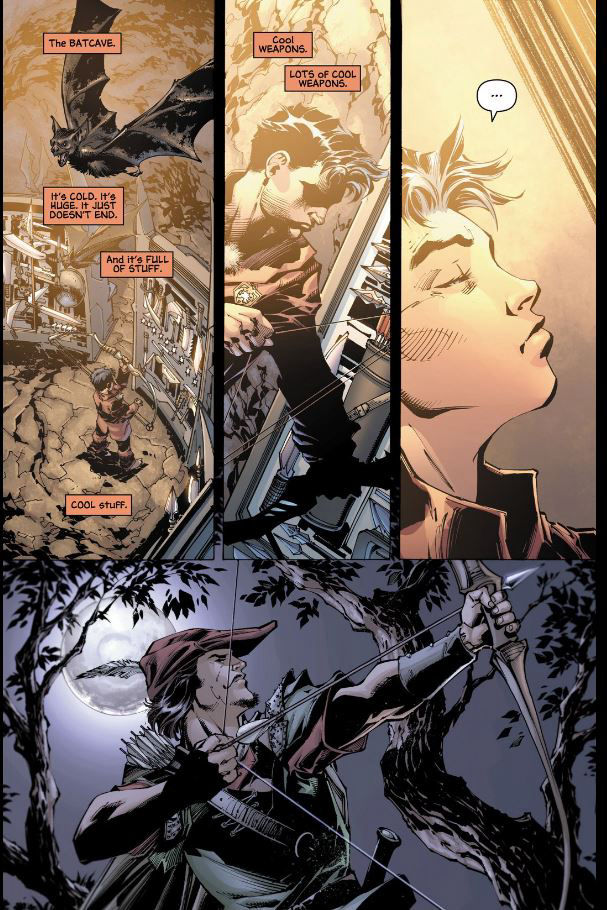
The young child orders Batman’s helper – Alfred the Butler, who is lurking in the shadows – to make him a costume, with a cape and a hood. When Batman returns to the cave, an arrow whizzes at him which he plucks from the air. “Nice shot, kid.” Dick stands revealed a more medieval variation of the classic Robin costume.
DICK: Don’t call me kid. Don’t call me boy. Don’t call me brat. Don’t call me a little snot. Call me Hood. My dad was always making me watch some old movie about Robin Hood. That’s why I became an archer. So call me Hood.
BATMAN: Hood, huh? Do you know what any thug with half a brain would do with that hood?
(Batman yanks the hood down over Dick’s eyes)
DICK: Hey ….!
BATMAN: Lose the hood. You’re Robin
- All-Star Batman and Robin the Boy Wonder, script by Frank Miller
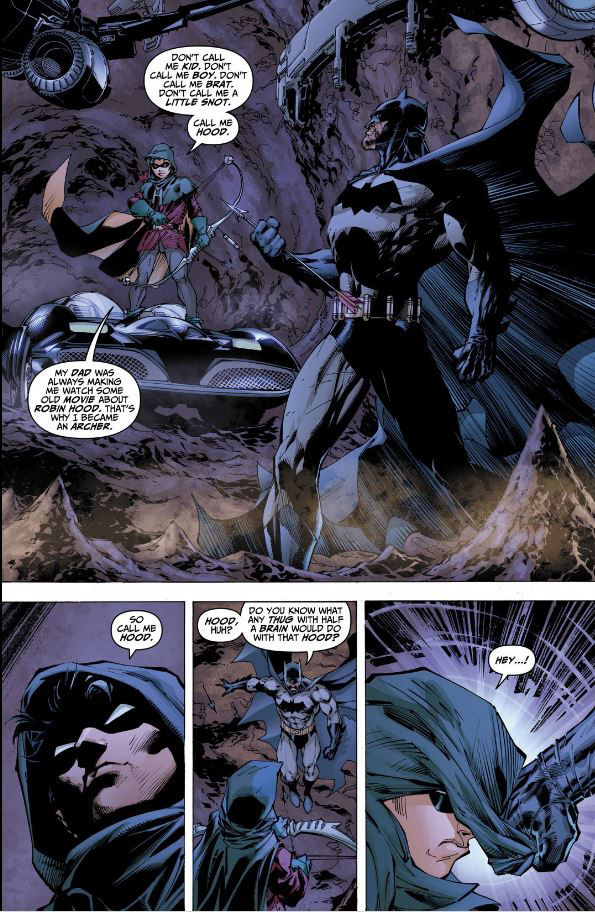
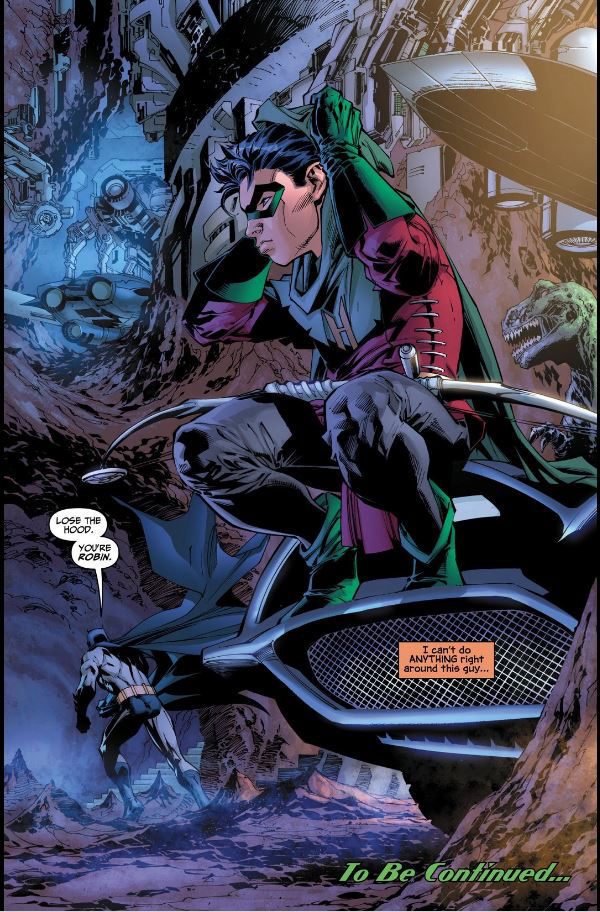
But is there any connection between Robin Hood and Robin besides the name? Well, let’s look at the text that appears on the very first page of first Robin story in Detective Comics #38.
The Batman. That amazing, weird figure of night, at last takes under his protecting mantle an ally in his relentless fight against crime ... Introducing in this issue ... An exciting new figure whose incredible athletic and gymnastic feats will astound you ... A laughing, fighting, young dare-devil who scoffs at danger like the legendary Robin Hood whose name and spirit he has adopted ... Robin the Boy Wonder
The first attribute the script assigns to this "exciting new figure" is that he is athletic with gymnastic skills. That's followed up in the story itself as young Dick Grayson was raised in the circus as an acrobat and trapeze artist.
It's also a trait strongly associated with the two most popular movie Robin Hoods of the time. Douglas Fairbanks' athletic and gymnastic feats were renown, and the castle set of his 1922 Robin Hood film was specially constructed to take maximum advantage of them. While not quite the gymnast that Fairbanks was, Errol Flynn has his moments to. In the forest ambush scene in the 1938 film, Flynn's Robin swings in on a rope -- just as the comic book Batman and Robin would later swing on their bat-ropes.
The fighting and “dare-devil who scoffs at danger” traits have been part of Robin Hood from the earliest ballads onward, as they are for most adventure heroes. In the 1938 movie, Errol Flynn’s Robin Hood breaks into Nottingham Castle with a dead stag on his shoulders and plops on Prince John’s banquet table in defiance of the royal’s forest laws against hunting deer. That’s the kind of cocky attitude that Finger, Robinson and Kane wanted their Boy Wonder to have.
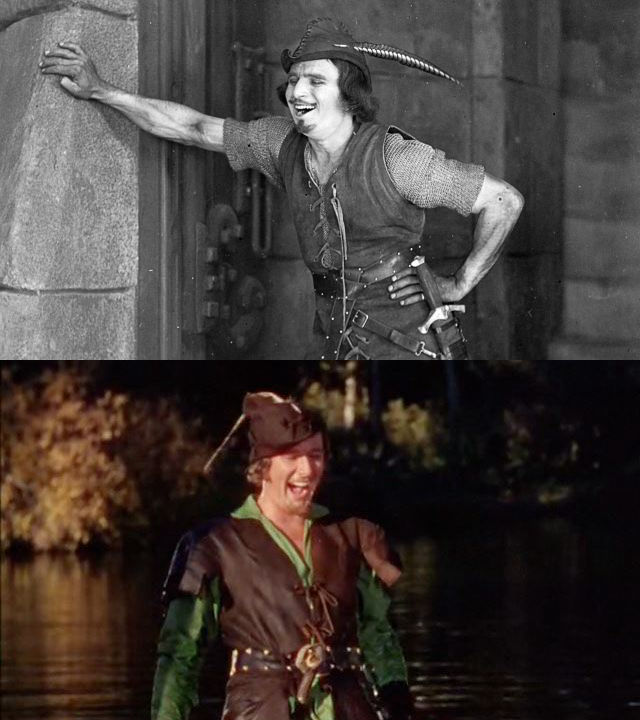
There are two traits that the early Robin the Boy Wonder stories call out repeatedly. The first is "laughing".
In both the 1922 and 1938 movies, Robin Hood cocks his head back and laughs heartily on several occasions. Robin Hood’s deep rich laugh has been parodied many times. In the 2014 Doctor Who episode “Robot of Sherwood” when the time-travelling Doctor barks at Robin Hood “Stop laughing! Why are you always doing that? Are you all simple or something?”
There’s a strong element of humour that runs from the earliest Robin Hood ballads to the best film and television versions of the legend. In the 1938 film when Maid Marian protests “Why you speak treason!” Robin of Locksley responds “Fluently.”
In an interview quoted in Daniels’ Batman: A Complete History, the writer Bill Finger notes the world of pulp novels and magazines that helped inspire the Batman were “grim and lacking in humor.” Of the Boy Wonder, Finger said “The puns were there; the dialogue easy, fluid, and flowing. It brightened up the strip and added characterization of the main figure of Batman.” While many have lamented that Batman moved away from the grim loaner of the earliest issues, there is a distinct spark and energy that comes from giving the Dark Knight something to talk to.
The Boy Wonder may be famous for his outrageous puns, the thing he’s best known for is being … young. He is a kid sidekick after all. It might seem at first glance that this is a departure from his Robin Hood namesake. The prologue of Howard Pyle’s much-reprinted 1883 classic children’s novel The Merry Adventures of Robin Hood of Great Renown In Nottinghamshire starts by describing Robin Hood may start by calling the lead character a “youth” but the full phrase is “a youth of eighteen, stout of sinew and bold of heart” – much older, and self-sufficient than how one would view a kid sidekick. Errol Flynn was in his late 20s when he played Robin Hood. And while Douglas Fairbanks may have a great boyish quality (early in his Robin Hood movie, he tells King Richard “I am afeared of women”, as if he expects to catch the cooties from them), Fairbanks was in his late 30s when donned the tights.
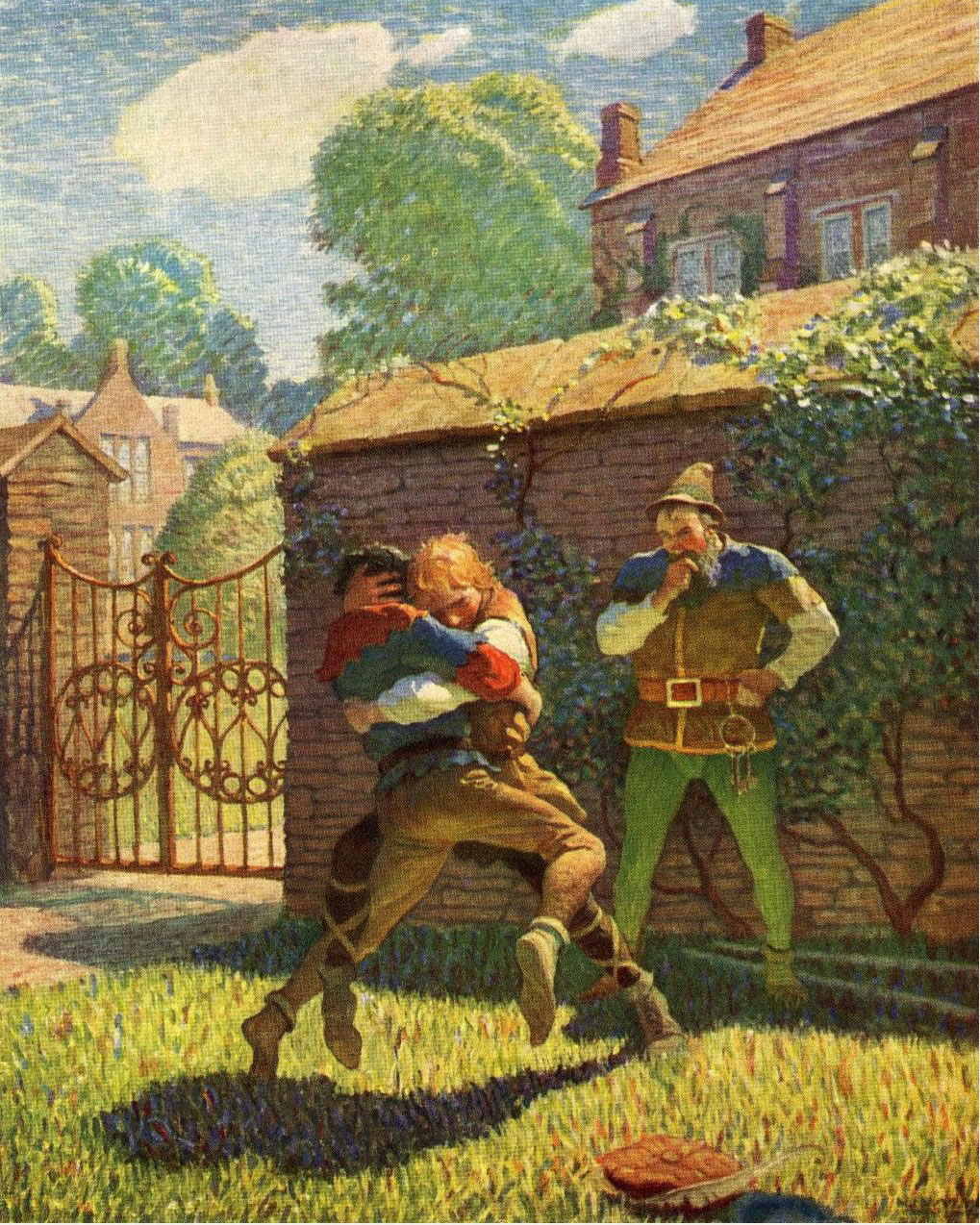
But it was not the Howard Pyle novel, nor the then two most famous film depictions that inspired the choice of name for Batman’s young partner. It was Jerry Robinson’s love of N.C. Wyeth’s illustrations. The Robin Hood novel that Wyeth illustrated was the 1917 edition of Paul Creswick’s Robin Hood (the exact title changes with the edition).
Creswick’s Robin Hood is a proper youth – not so “stout of sinew” as Pyle’s – for several chapters. Creswick’s young Robin Fitzooth has several adult mentor figures – his father, the forester Hugh Fitzooth, who dies, his rich and somewhat misguided maternal uncle George Montfichet of Gamewell who fosters Robin, the hall’s servant Warrenton, and the outlaw leader Will o’ th’ Green who is fond of the lad. If ever there was a Robin Hood who fit the kid hero mold, it’s Creswick’s.
However, what’s delighted fans of Batman and Robin for 80 years now is not a few caption text descriptors. It’s the stories themselves. In the next section we’ll examine some of the Boy Wonder’s earliest tales and see if we can see an outlaw hero lurking within.
But what about the whole "robbing from the rich and giving to the poor" aspect of Robin Hood? It took a bit of time for that to become part of Dick Grayson's character. In 2016, Dick Grayson had long ago given up the Robin identity. He'd been operating under the alias of Nightwing for over three decades. But when writer Tim Seeley worked on the relaunched Nightwing comic book, he established that Dick Grayson was a Robin Hood fan.
In issue 3, Dick Grayson allies himself with a criminal anti-hero Raptor, and his on-again off-again love interest Barbara Gordon aka Batgirl sees the Robin Hood connection calling it his "Robin Hood thing".
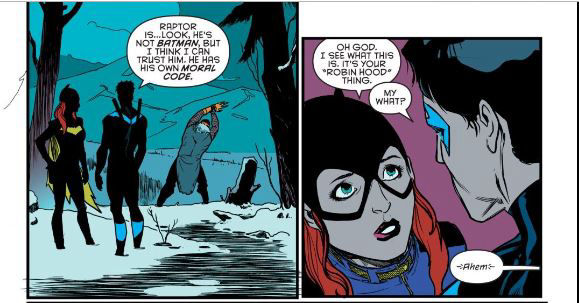
My "Robin Hood" thing.....
When I was with the circus, we didn't have much. It was hard to compete with DVDs and big-screen TVs. Other kids had cartoons and movies to watch. All I had was a permanently borrowed library book, The Merry Adventures of Robin Hood.
On rainy days, or while waiting to leave, I read that book over and over to ease my "itchy feet".
Heroes. Villains. Sword-fighting. Arrow shooting. And a hero who worked for the little guy. The poor guy. Like me. Like my family.
There was a moment when Bruce introduced me to his world of "crime-fighting" when I thought of Robin Hood. Sure, Tony Zucco was a criminal. But he was also a rich guy who thought he could do whatever he wanted to a bunch of circus performers.
There was a moment when I asked myself: What if we didn't fight crime? What if we fought poverty.
I told that to Barbara once. Without skipping a beat, the daughter of a police commissioner said ...
"... If you stole from the rich and gave to the poor...
"... you'd be a criminal."
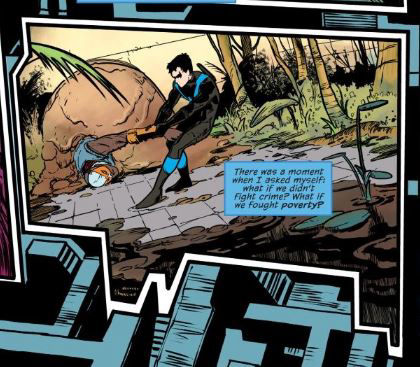
Seeley's script refers back to Robin's first adventure in 1940, when Batman and Robin took on mob boss Tony Zucco. But back in those earliest adventures, it wasn't just Tony Zucco who was a criminal. Batman and Robin -- despite fighting on the side of right -- often were off viewed suspiciously by the cops. In a sense, Batman and Robin were outlaws too.
Next section I'll look at some of those early stories.
NEXT:
PART 3 - Early Adventures (including Robin's origin)
PART 4 - Batman and Robin meet Robin Hood in The Rescue of Robin Hood (Detective Comics #116)
PART 5: The Caped Crusaders in 1950s and 1960s Comic Books and Television
PART 6 - Batman and Robin Meet the Archer (1966 TV episodes)
PART 7 - Robin Leaves the Nest (1969 - 1975)
PART 8 - The Dynamite Duo and Goodbye, Hudson University (1975 - 1980)
PART 9 - Robin No More: The Birth of Nightwing (1980 - 1984)
PART 10 - Reboots and Retcons (1984 - Present)
PREVIOUSLY: Part 1 - The Golden Age of Comics and the Development of the Kid Sidekick
Contact Us